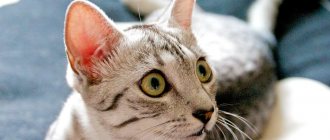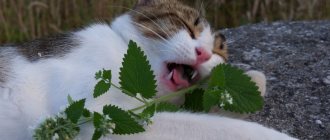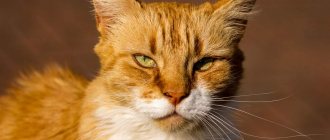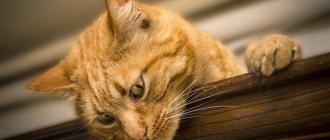Bastet - the mother of all cats
In Ancient Egypt, Bastet or Bast was revered as the goddess of cats, love, beauty, fun, hearth and fertility. This deity was associated with successful childbirth in women. Bast was the main protector of family and home. She was also considered all-seeing, therefore she was part of the guard of the god Ra.
Bastet had 2 incarnations: good - a woman with a cat's head and evil - a woman with the head of a lioness. Being in an aggressive form, the goddess turned into Sekhmet, a lioness who once almost destroyed the inhabitants of the earth. The Greeks identified Bastet with such influential goddesses as Aphrodite and Artemis.
Divine cats and women's magic.. Part 1.1
Quote:
“In a cat I see a woman with an ever-changing, sensitive soul...” (Giacomo Casanova)
I'll start with Ancient Egypt.
The cat family is magnificent and amazing. From time immemorial, its representatives were worshiped, surrounded by secrets, and mysterious mystical traits were attributed to them. Since ancient times, the cat has been more strongly associated with witchcraft than any other animal. In this chapter we will look at the legendary magical abilities of famous cat goddesses, list their unchanging attributes - colors, stones, crystals, herbs, and provide other information. And of course, each goddess mentioned here is addressed to a special cat spell according to their witchcraft specialty.
If you now ask why this chapter is dedicated only to goddesses, the answer is obvious. The sorceress cat is mysterious in a feminine way. It all began many thousands of years ago with the deification of Bast and other Egyptian cats in the Nile Valley. It is impossible to talk about divine cats without first remembering Ancient Egypt. In the Egyptian kingdom, cats were sacred temple animals, beloved pets of ordinary people and pharaohs. Many Egyptian deities - the fertility goddess and symbol of femininity Isis, the sky goddess Hathor, the avenger Mafdet, the mistress Mut, the hunting god Horus, the sun god Ra, the goddess of war and the scorching sun Sekhmet, the desert god and the personification of evil Seth - are associated with wild and domestic cats.
Apparently, most Egyptian cats were reddish, brownish, and golden. On the steps of the tombs of the pharaohs, brownish cats are depicted with the same pattern as the modern tabby.
Stately, arrogant cats sit under the pharaoh's throne, enjoying the royal life. Egyptian cats guarded grain warehouses from snakes and rodents, and in homes they occupied a place of honor near the hearth.
The Egyptians believed that cats had enormous magical powers and intuition. The law prohibited intentionally harming them. Fools who violated it were subjected to severe punishment, including death.
However, the ancient Egyptians saw the cat as a symbol of the highly revered cat-headed goddess Bast, who was very popular in Egyptian mythology two thousand years before Christ and remains a traditional goddess for cat-loving witches today. Therefore, let's start with the myths about this charming goddess, who is called the “foremother of cats.”
BAST, THE FOREMOTHER OF CATS Thousands of years ago, cats were deified. They do not forget about it. (Famous expression)
Bast is the goddess of fertility, motherhood, sexuality, love, music. She is most often depicted as a woman with a cat's head, wearing a long, tight green dress, holding a basket or a sistrum, a musical instrument.
Sometimes she can be seen with kittens playing under her feet - a symbol of motherhood. A black cat is dedicated to the goddess Bast, with whose head she is usually depicted.
In some myths, Bast is called the daughter of the sun god Ra and the goddess of magic Isis, in others she is called the firstborn daughter of the sun god Amun. She became the wife of Ptah, the god of the city of Memphis, personifying the soft light of the rising sun, for which she was nicknamed the “sunny eye”. At first Bast was a solar goddess, later she began to symbolize the moon - waxing and waning. It is also called Bastet, Ubastet and Pasht.
The sacred city of the cat goddess was Bubastis. In her temple, rumored to have been built of red granite, there was a luxurious niche, densely overgrown with greenery, in which was the tomb of Bast. In the temple at Bubastis there lived many cats, which were groomed and cherished in every possible way, like a living personification of the goddess.
The sanctuary served not only as the main center for the deification of the sacred temple cats, but also as a burial place for thousands of deceased domestic animals. The Egyptians believed that beloved animals resting in a sacred place would carry their prayers to the gods. In 1887, the French archaeologist Edouard Naville discovered during excavations the main temple of Bubastis, cellars with mummies of cats and several royal tombs, obtaining evidence of the veneration of the goddess Bast by the Egyptian pharaohs.
Bast may have originally had a lion's head, like her evil sister Sekhmet, the goddess of war. But over time, Bast turned into a more meek feline, more like everyone's favorite domestic cat. This is an affectionate, loving goddess, however, she jealously guards her children, from whom she is not easy to drive away.
The formidable hypostasis of Bast is called Pasht. Imagine a lioness protecting her cubs.
Interestingly, Pasht is sometimes depicted with wings. Some myths connect her with the falcon god Horus. You can see Pasht in the form of a falcon with a cat's head or a regal cat with outstretched wings.
In mid-April, the Egyptians' favorite spring festival was celebrated in honor of Bast. According to some reports, thousands of Egyptians marched in parade formation, singing, dancing, and playing musical instruments. Doesn't it look like a Maslenitsa celebration? Talking about this festival, the ancient historian Herodotus mentions with slight indignation that women lifted their skirts over their heads in full view of passers-by. Bast's admirers had a lot of fun at the festival.
If you decide to cast a spell addressed to Bast, try asking her for fertility, easier pregnancy, and increased sexuality.
Spell to Bast
Bast's magical attributes are simple and obvious. All cats and kittens of any breed and color are dedicated to her. Her color is green, the color of fertility. The list is completed by a simple wicker basket, the musical instrument sistrum and the planets associated with the goddess - the Sun and the Moon.
Try casting the spell on Sunday (when the solar influence is especially strong) or on Monday (when the magical influence of the Lupa is increased).
Ladies, don't forget to line your eyes. I'm not joking at all. Ancient Egyptian women are invariably depicted with heavily lined eyes in imitation of the huge, beautiful almond-shaped eyes of the goddess Bast. If you want to do magic, resort to magical cosmetics. Take a bold jet black pencil and clearly outline your eyes above the upper and lower lashes. If you want to gain more strength, draw the bottom line further away.
Sometimes all it takes is a small spark to bring passion and joy into a relationship. Between family and work, try to carve out a romantic moment exclusively for yourself and your loved one. Try to get his attention. The rest is up to both of you.
ACCESSORIES
• A couple of fresh catnip leaves (for beauty, happiness, love, cat magic)
• Black eyeliner (optional)
• Green candle for Bast
• Candlestick
• Lighter, matches
• Table, shelf for candles
DIRECTIONS: Line your eyes like the beautiful Bast. This ritual is best done in the bedroom. Place a catnip leaf under a candle in a candle holder. Give another leaf to the cats as an offering to Bast. They will be happy and will not go to the candle. Remember that Bast is the goddess of sexuality and fertility, be sure to protect yourself accordingly. Light the candle and repeat the following spell three times:
In the name of Bast, the cat-goddess of love and passion, I conjure my beloved to warm up and give me happiness. May he and I always have fun together, and a fulfilled wish will not harm anyone.
How was Bastet portrayed?
Most often you can find her image in the form of a cat or an elegant woman with the head of a cat. True, before the domestication of the cat, she looked like a lioness. The color of the goddess was black.
The main attribute of Bastet was the sistrum - a percussion musical instrument, a symbol of fun and happiness. It is this that the goddess, as a rule, holds in her hands. The sist itself was often decorated with images of cats. Four kittens were often painted at the feet of the goddess, which were associated with fertility, prosperity and protection of children.
What is consciousness?
Defining consciousness is difficult. How to answer the question “why am I me” or “how does my consciousness differ from the consciousness of a cat?” or “why do I perceive the world this way and not otherwise?” Fortunately, there are scientists in the world who are ready to answer, if not all, then many questions about what human consciousness is.
For example, cognitive philosopher Daniel Dennett, a professor at Tufts University (USA), in his book “From Bacteria to Bach and Back” talks about how biological processes in the human body create a flow of thoughts and images. The professor believes that the subjective film that plays before the eyes of each of us is nothing more than an illusion skillfully woven by our brain. He also believes that consciousness is not as mysterious as we think and believes that science must explain the objective functioning of the brain.
Consciousness is the human ability to reproduce reality in thinking.
Among the scientists who disagree with Dennett's point of view is the Australian philosopher and teacher David Chalmers. He suggests that consciousness should be viewed as something fundamental, such as the laws of physics, that can be discovered in the future with the help of new technologies. His second, even more radical idea is called the “panspichism hypothesis,” according to which consciousness is universal and every system has it to some extent, even elementary particles and photons. And where there are photons, there can be quantum mechanics.
How was Bastet revered?
The heyday of the Bastet cult dates from the 10th to the 8th centuries BC. At that time she was considered a national deity. Although temples dedicated to the goddess existed in various cities, the main place of worship was the city of Bubastis. It was a pilgrimage center that thousands of people sought to visit. The temple at Bubastis was surrounded by a wall richly decorated with reliefs. Inside was a huge statue of Bast. It was customary to bring small cat figurines as gifts to the goddess.
Bastet's veneration was expressed in relation to cats. For example, in memory of a deceased cat, the owner could shave his eyebrows. A driver who accidentally ran over a cat could be stoned by the crowd. The punishment for damage to an animal was determined by the importance of the cat. In addition, archaeologists have discovered thousands of cat mummies.
Almost every temple had its own “cat guard.” These priests carefully watched the temple cats so as not to miss a secret message from Bastet. Egyptian houses often kept figurines of cats, which were supposed to resist evil forces. The Egyptians also believed that after death the soul of the mistress of the house moved into a cat. Amulets with images of cats were a guarantee of fertility.
Herodotus's History included a description of the annual ancient Egyptian celebrations held in honor of Bastet. They fell on April 15th. On this day it was customary to dance and have fun. The priests loaded the statue of the goddess into a boat and solemnly transported it along the banks of the Nile. According to Herodotus, 700 thousand people flocked to the city of Bubastis during the holiday. And although the number of pilgrims is most likely exaggerated, it indicates the significance of the holiday.
Even the pharaohs were averse to making sacrifices in the temple of the goddess. It is interesting that the arrows with which the Egyptians emphasized their eyes were also an attempt to imitate Bastet. True, the love of cats once played a cruel joke on the Egyptians. This happened in 525 BC. Then the Persian king Cambyses stormed the Egyptian city of Pelusium. To weaken the resistance of the Egyptians, he placed troops of cats in front. This story is most likely anecdotal, but notes the importance of cats to the Egyptians.
End of the cult
Under the new government, the veneration of cats became more difficult, and the temple in Bubastis fell into disrepair. However, the cult persisted until the establishment of Roman rule. Practical Romans did not see anything special in the cat: at best, an ordinary mouse hunter. However, memories of the former heyday of the cat cult remained. Therefore, sometimes the Romans could play on the religious feelings of the Egyptians, if for some reason they did not behave too loyally. One of the Roman governors, faced with disobedience, ordered to catch all the black cats that could be found and kill them. This immediately brought the rebellious Egyptians to their senses.
Myths about Bastet
All significant Egyptian gods were closely related to each other. Bastet did not escape this fate either. She was the daughter of the Sun God and the Moon Goddess. Her sister was the goddess of heaven, Nut, who was highly revered in Egypt. True, Bastet got the jester of the gods Bes as her husband.
The divine couple had a son, Mahes, a lion-headed god who kept order and was a warrior-defender. Modern worshipers of the goddess Bastet like to associate her with Anubis. At least, on the Internet you can find a huge number of pictures depicting these gods together. But scientists have not yet found confirmation of this idea in Egyptian mythology.
A legend has reached our time that tells of the enormous service that Bastet provided to her father, the god Ra. When people took up arms against the Sun God, he turned to his daughter for help. To punish people, Bastet turned into a formidable lioness, killing everyone. And only by cunning Ra was able to pacify her anger.
The cult of Bastet flourished in Egypt until the 4th century AD. With the spread of Christianity it was banned. Moreover, the extermination of black cats began, a prejudiced attitude towards which persists to this day.










